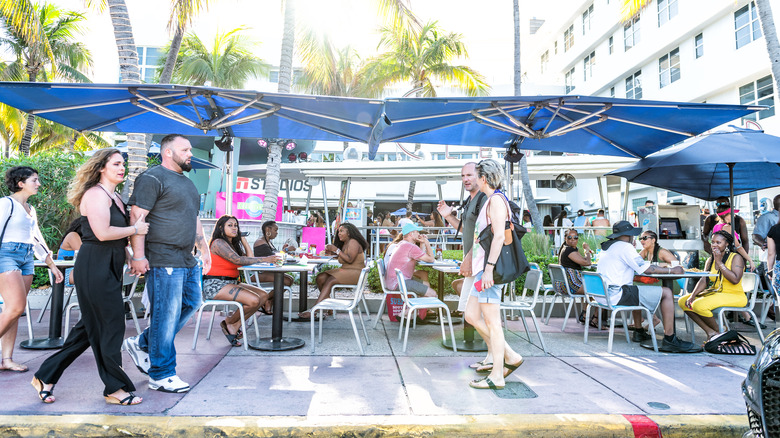The Top 5 Foodie Cities In America For 2025 (And NYC Didn't Even Make The Cut), Per A Study
They say the way to one's heart is through their stomach, and some American cities happen to understand this better than others. Using 28 key metrics to evaluate the foodie scenes of 182 U.S. cities, personal finance firm WalletHub revealed 2025's Best Foodie Cities in America — and the results defied expectations, with perennial favorite New York City failing to make it to the top five.
Miami victoriously claimed the No. 1 spot as America's Best Foodie City with a burgeoning food scene that delivers on two key factors: a balance of diversity, accessibility, and quality with affordability. The intent of the study was to probe beyond each city's dining-out culture — WalletHub considered the gamut of the foodie experience, from the availability of Michelin-starred restaurants to food trucks; the presence of farmers markets and food festivals; the cost of groceries; and the overall quality of a city's food experience. "The top cities cater not just to people who enjoy dining out, but also to foodies who enjoy putting their own skills to the test by exploring new flavors in their own kitchens," said WalletHub analyst Chip Lupo.
So who else made it to the top five? Portland bagged the No. 2 spot with its wealth of craft breweries and food festivals, proving that it's got more clout in the food scene beyond its status as the coffee capital of America. San Francisco followed close behind as proud host to a jaw-dropping number of Michelin-starred restaurants, while Seattle came in fourth, scoring high in restaurant, craft brewery, and winery volume per capita. Finally, Orlando rounded out the top five. Now, enough with the appetizers — let's get to the main dish and dig into what makes these cities magnets for foodies.
Miami
The Florida food scene got a major boost when five restaurants across the state earned coveted Michelin stars, with Miami at the helm with the most stars (that's 13 and counting) under its belt. Fine dining aside, what ultimately propelled Miami to the top of WalletHub's Best Cities for Foodies list was its diverse range of affordable restaurants per capita. Drawing on the flavor of its melting-pot cultural scene, Miami's food offerings stretch far and wide. It's a city where one can tuck into a plate of crisp Venezuelan palmeritas for breakfast, chomp on hearty Cuban sandwiches from cafeteria-like eateries for lunch, or dig into a plate of authentic Puerto Rican mofongo for dinner — all at prices that can't be beat. Miami also tied for first place (alongside Las Vegas, Orlando, San Francisco, and Houston) as the city with the highest number of restaurants per capita.
Though the thrill of a five-course tasting meal or a late-night food truck snack run is always within a foodie's reach, the city caters to the mundane yet rewarding routine of home cooking and grocery shopping. WalletHub's findings reveal Miami as having myriad of farmers markets, gourmet specialty stores, butcher shops, and homeware stores for the culinary homebodies. Regular food events and festivals happen around the city as well: You can round up your friends for intimate chef-hosted dinners; rub elbows with Food Network personalities at the South Beach Wine & Food Festival; or hop on a golf cart tour of the city's artistic district while sipping locally brewed craft beer.
Portland
Portland secured the title of America's second-best foodie city without a single Michelin-starred restaurant to its name — proof that exceptional access to affordable and diverse food and drink options (as well as food events) is what it takes to build a worthy culinary scene. A staggering number of restaurants populate the city, with the majority of them earning high approval — at least 4.5 out of 5 stars — from discerning diners. The city tied for first in the study's combined category for craft breweries and wineries per capita, a testament to more than 80 craft breweries that churn out acclaimed IPAs and the thriving brewpub culture that has emerged. Portland's access to around 250 wineries spread over acres of land in the nearby Willamette Valley also helped propel it to its top ranking.
And if you're overwhelmed by the food choices, book one of the numerous food tours suited to any palate, whether you're into pedaling your way through the food cart scene or are seriously ready for an immersive three-day food tour — or "tour de forkm,"" as Travel Portland lovingly dubs it — of the Portland foodie scene. If you want to peruse the food scene at your own pace, drop by one of Portland's food halls or markets.
The icing on the cake: There's no sales tax in Oregon. This means that food-related activities in Portland are easy on the wallet, whether it's splurging at a restaurant or picking up local produce from one of Portland's numerous farmers markets or specialty food stores.
San Francisco
Although the San Francisco food scene comes at a high cost — it placed 178th out of 182 total cities in terms of affordability — it pulled its weight when it came to food diversity, accessibility, and quality. San Francisco earned a handful of accolades in the study: It ranked first in terms of restaurant-to-population ratio, fourth place for healthy food access, and sixth place in restaurant diversity. Despite being only a tenth of the size of Los Angeles, San Francisco houses 30 Michelin-starred restaurants — yes, 30 — alongside iconic waterfront marketplaces brimming with artisanal shops and mouth-watering eateries.
San Francisco is also fiercely proud of its innovative culinary reputation — and doesn't let anyone forget it. Edgy, inspiring, and influential chefs have emerged from this city, which has proudly laid claim to the iconic Mission burrito and Boudin sourdough bread — likely fueled by the numerous food festivals and an impressive number of cooking schools throughout the city. Foodies have no shortage of resources when it comes to culinary exploration, with curated food-related establishments — including international groceries, specialty food stores, craft breweries, and wineries – within reach.
Seattle
Claiming the No. 4 spot is Seattle. Known for a slew of renowned chefs, seafood, and a strong coffee culture, the city doesn't take its food scene lightly. Locals are known to put more emphasis on the quality of a dining experience over a grab-and-go meal, as evidenced by Seattle scoring fifth place in the study's full-service restaurant-to-fast-food establishment ratio.
Though surrounded by more than 900 wineries — some within half an hour's drive from the city — Seattle also cultivates a thriving urban wine collective, making wine tastings more accessible to local oenophiles. These wineries rub shoulders with the large number of craft breweries populating the neighborhoods of SoDo, Fremont, and Ballard. Trendy new restaurants keep popping up, while historic eateries — like Seattle's first sushi bar, which opened in 1904, and a Pioneer Square saloon that's been serving fried curds since 1890 — continue to thrive. Unfortunately, Seattle ranked 166th in WalletHub's affordability metric, indicating that there's a (high) price to pay for the city's quality food scene.
Orlando
Rounding out the top five is Orlando, a foodie city second only to Portland in the study's affordability metric. It tied for first with San Francisco and Miami in restaurants per capita, an achievement reflecting an "onward and upward" attitude: Forbes reported that Orlando restaurant licenses have steadily been on the rise. Dining choices abound with diverse cuisines across every budget — diners can enjoy a casual food truck meal one day and book a tasting menu at a Michelin-starred restaurant the next, with nine in the city — just four short of Miami's 13.
The city also features an abundance of gourmet and specialty food stores — everything burgeoning chefs may need to craft delicious home-cooked meals. And, perhaps due to the Sunshine State's enviable, practically year-round sunny weather, the city seemingly has no shortage of icy treats: WalletHub's results showed Orlando to have the most ice cream and frozen yogurt shops per capita, sharing the top spot with fellow sun-soaked cities including Miami and Las Vegas.
Methodology
In its quest to find 2025's best foodie cities, WalletHub evaluated 182 cities on a 100-point scale, examining two key dimensions: a city's "Diversity, Accessibility, and Quality" (70 points) and "Affordability" (30 points). Multiple relevant metrics contributed to each dimension's total score. These included restaurants per capita, restaurant diversity, Michelin-starred restaurants, and access to healthy food options, among others, for "Diversity, Accessibility, and Quality." The study weighed costs related to groceries, restaurant meals, sales and food taxes, and average beer and wine prices for the "Affordability" factor.
WalletHub relied on data from sources including the U.S. Census Bureau, Tax Foundation, TripAdvisor, Yelp, and Wikipedia, among others, to complete the study. To provide context, we consulted websites like Condé Nast Traveler, Food & Wine, Forbes, Eater, Michelin Guide, and city-specific websites to gain a fresh perspective on each city's food scene.






